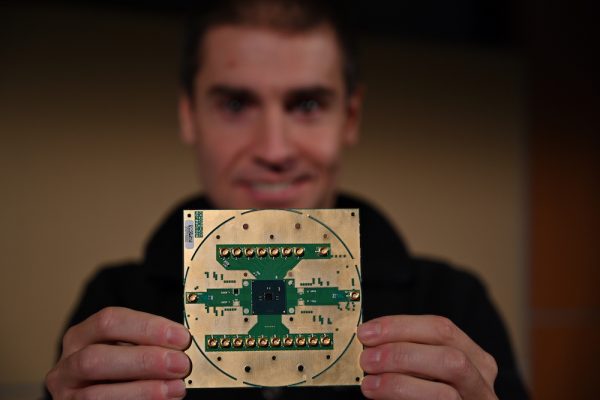The Spooky Network: Is the quantum network the future of the Internet?

Perfecting the quantum computer could finally be in reach. Data and communications are now an enterprise’s most precious asset. If a quantum network could be developed, what would this mean for businesses?
According to research from Quantum Technology (IQT), the market for quantum networking could reach $5.5 billion in just five years’ time. Google’s quantum computing project has claimed the high ground after they published their results in Nature, yet IBM has questioned some of the claims being made by Google, as Silicon UK covered last year. And Honeywell has stated they will launch a quantum computer later this year that will outperform IBM and Google’s technologies.
As the tech behemoths debate who has actually made any advances with quantum computers, Intel in collaboration with QuTech – a partnership between TU Delft and TNO (Netherlands Organization for Applied Scientific Research) has outlined the hardware components that will be needed to create a quantum computer, which could form the basis of future quantum networks.
Intel calls the chip ‘Horse Ridge’ with Jim Clarke, Director of Quantum Hardware, Intel Labs stating: “Today, quantum researchers work with just a small number of qubits, using smaller, custom-designed systems surrounded by complex control and interconnect mechanisms. Intel’s Horse Ridge greatly minimizes this complexity. By systematically working to scale to thousands of qubits required for quantum practicality, we’re continuing to make steady progress toward making commercially viable quantum computing a reality in our future.”

Stefano Pellerano, principal engineer at Intel Labs, holds Horse Ridge. The new cryogenic control chip will speed development of full-stack quantum computing systems, marking a milestone in the development of a commercially viable quantum computer. (Credit: Walden Kirsch/Intel Corporation)
CIOs and CTOs have quantum computing on their radars, but the question many are asking is whether this technology will offer real-world applications any time soon? Says Matthew Brisse, VP Analyst, Gartner: “Quantum computing is heavily hyped and evolving at different rates, but it should not be ignored. It holds great promise, especially in the areas of chemistry, optimization, machine learning and AI to name a few. Today’s data scientists simply cannot address key opportunities in these areas because of the compute limitations of classic computer architectures.”
Kevin Deierling, Senior Vice President at Mellanox Technologies also explained: “Today quantum computers are relatively narrowly targeted at advanced forms of encryption. For the broader class of AI workloads, GPUs are much more practical and economical.
“However, in the future, as quantum computers mature, they may begin to be able to address a broader class of economically important workloads, including artificial intelligence. Despite the incredible state parallelism inherent in these quantum machines, they will nonetheless be limited in scale.”
Deierling concluded: “So, in the near-term practical quantum computers will be limited to less than 100 qubits. Thus, to solve the largest problems facing business and government will require distributed quantum computers (DQCs). These DQCs will need advanced quantum networks both to communicate between and individual quantum elements and to access and share the data sets needed is input state for these systems.
“These quantum networks will incorporate intelligent processing capabilities and ultimately become an integral and critical part of the DQC, in much the same way that SmartNICs and I/O processing units (IPUs) are integral to the large-scale classical web-scale computers and cloud data centres of today. Regardless of whether connecting classical or quantum computers, advanced network innovation will be key to the advancement of these ever more powerful computing machines.”
For the internet to transform using quantum technologies, a major shift would have to take place with how the network is organised and built. Alessandro Lumino, Software Developer Engineer, NTT DATA commented: “A typical quantum channel could be a telecom fibre. However, as we know with today’s communication networks, a drawback of fibres is that they experience signal losses over large distances, so the signal has to be repeated somehow to be transmitted over long distances.

“Quantum repeaters are hence essential for a quantum network. These repeaters strongly rely on quantum ‘teleportation’ and quantum memories. The memories store the state of the qubit to be teleported for a certain amount of time and need to be free from errors, otherwise, the state of the qubit would be lost. Unfortunately, no truly quantum repeaters have been realised at the time of writing.
“Creating these repeaters is the main barrier to building a quantum network. There is ongoing work in this area though. QuTech, an advanced quantum research centre in The Netherlands, has promised to deliver the first real-world example of a complete quantum network linking Delft, the Hague, Leiden and Amsterdam by the end of 2022.”
Is there a business case for quantum computers and networks? The work being done by IBM, Google and others notwithstanding, the business case for quantum computers, sensors, networks or anything else you can prefix with the word ‘quantum’ are difficult to define. Security is often the focus of debate regarding quantum computers in particular. We are several years’ away from practical applications of this technology. It does, though, remain highly intriguing.
Silicon in Focus
Hugues de Riedmatten, ICREA Professor at ICFO.
Hugues de Riedmatten is ICREA professor and head of the Quantum Photonics group at ICFO- The Institute of Photonic Sciences, in Barcelona, Spain. His group´s research focuses on experimental quantum information science and quantum optics, including quantum memories for light, quantum light sources, quantum networks nodes and quantum frequency conversion.

How would a quantum internet differ from the internet we know today?
The main difference is that a quantum internet works with quantum bits instead of classical bits. A quantum bit is a superposition of two states (0 and 1). Similarly, to the classical internet, the quantum internet is composed of nodes to process information and channels to distribute this information.
But in the quantum case, the nodes are quantum processors (which ultimately can perform quantum computation) and quantum information is transferred between them using single photons as quantum bits. Entanglement (a form of purely quantum very strong correlations) can also be distributed through the network. The ability to distribute quantum bits and entanglement gives quantum networks fundamentally different capabilities than the classical internet.
What are the key use cases for using a quantum network?
The main current use case of a quantum network is insecure data transmission, i.e. to perform secure transmission of information through the network using quantum key distribution.
By using quantum bits encoded in photons one can distribute a cryptographic key whose security is guaranteed by the laws of physics, which would be secure against any supercomputer or even future quantum computers. On short-distance networks, this application is already a reality. Reaching longer distances in optical fibres requires new quantum hardware to build a so-called quantum repeater.
While quantum security is the most immediate application, there are also plenty of other applications offered by quantum networks: On a longer-term, when quantum nodes become more powerful, other use cases will emerge. For example, one possibility is to connect atomic clocks, which will strongly increase their synchronization and precision, a feature which may find applications in high precision geo-positioning.
Another interesting potential application is the so-called blind quantum computing. Imagine you want to connect to a quantum computer to perform a simulation of a novel material or drug design. Using a quantum network allows you to do this without revealing to the owner of the quantum computer (or anybody else) which problem you are searching to solve.
Finally, in its more powerful form and as an ultimate goal, the quantum internet will enable connecting quantum computers, allowing an exponential increase of computational power with the number of nodes.
Where are the current challenges building a practical quantum network?
Building the quantum hardware (quantum processors, quantum memories, entanglement sources) with the performances required to make a quantum network is extremely challenging. It will require to solve many scientific and technical challenges.
Quantum entanglement is very fragile and cannot survive for a very long time with current quantum hardware. One of the main challenges is to distribute entanglement across the network at a much faster rate than what it is degraded and eventually lost.
This can currently only be done across short distances and, extending it to longer distances will require enormous progress in the performances of the quantum nodes, e.g. in terms of efficiency of absorbing/emitting a photon, of storage time and of multiplexing capabilities.
Controlling quantum effects like entanglement in quantum nodes is extremely challenging and requires usually very low temperatures and very complex experimental setups. To create large-scale robust quantum networks, it will be necessary to build more practical and simpler quantum nodes which can be mass-produced. Achieving such required performances in a practical quantum node will be a major challenge.
As in classical networks, the quantum internet will likely be heterogeneous, with different kinds of nodes with different functionalities connected to the network. For example, some nodes might be adequate for performing quantum processing while others may be better for multiplexed quantum memories or sensors. Distributing quantum bits and entanglement using photons between very different types of nodes will also be a great experimental challenge.
What are the security implications of using a quantum network?
In a quantum network, the security of data is guaranteed by the laws of physics and does not depend on the progress of computational power, as is the case for current encryption. The achieved security is therefore long-lasting. Quantum networks can be used to transmit highly sensitive data, e.g. confidential governmental or corporate data. Another important use case is for health-related data, which should remain private for long periods of time.
How should businesses prepare for the arrival of quantum network technologies?
Building a practical quantum network will be a challenging endeavour which will probably require the collaboration of many actors, including quantum scientists, quantum hardware and software providers and network providers, to name a few. Companies active in quantum technologies may play an important role in the deployment of quantum networks, by mass-producing the key building blocks of the network.
It is still not clear what technology will be used for many of the components (e.g. quantum memories or processing nodes), and scientific research is still needed. However, the first elementary proof of principle demonstrations is within sight.
Several programs worldwide are working towards such demonstrations, such as in China, USA or Europe, this latter with the ambitious European initiative known as the Quantum Flagship, and in particular with one of its projects, the Quantum Internet Alliance (QIA), which is pushing to build the quantum internet.
Potential users of quantum networks should prepare by talking to scientists to understand better what are the capabilities and opportunities that this quantum technology provides. Small scale networks enabling quantum key distribution over a short distance will be deployed in the next few years (see. e.g. the European quantum communication infrastructure). Longer scale networks for distances larger than a few hundred km, and with capabilities beyond QKD are still at a research and development stage.